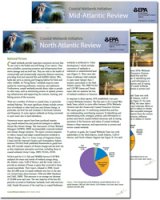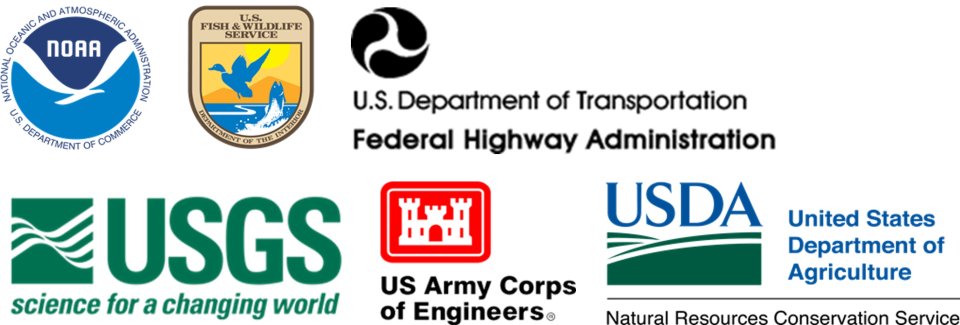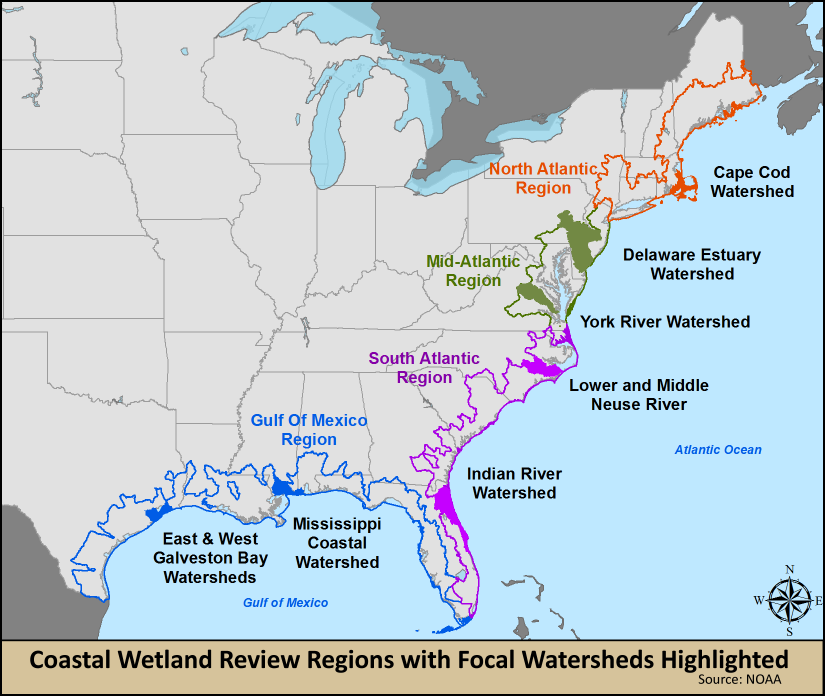EPA’s Efforts: Coastal Wetlands Initiative
Coastal Wetlands Initiative

The Coastal Wetlands Initiative was established by the EPA in response to the loss of coastal wetland acreage identified through the U.S. Fish & Wildlife Service's and National Oceanic and Atmospheric Administration - National Marine Fisheries Service's Status & Trends of Wetlands in the Coastal Watersheds of the Eastern United States, 2004-2009 (PDF) (58 pp, 14.93 MB). Coastal wetlands in the eastern United States were lost at an average rate of 59,000 acres per year between 1998 and 2004, even while inland wetlands acreage across the United States was increasing. From 2004 to 2009, wetlands were lost an average rate of about 80,160 acres per year in the coastal watersheds of the Atlantic, Pacific, the Gulf of Mexico and the Great Lakes. The initiative addresses the need to enhance conservation of coastal wetlands.
Partnerships
EPA works on the Coastal Wetlands Initiative in partnership with a number of federal agencies involved in coastal wetlands conservation. Agencies in the Interagency Coastal Wetlands Workgroup include:

Goals of the Interagency Coastal Wetlands Workgroup (ICWWG)
The ultimate goal of the Interagency Coastal Wetlands Workgroup is to reduce and reverse the trend of coastal wetland loss. The immediate goals of the workgroup are:
- To better understand the underlying causes of wetland loss in coastal watersheds and contributing stressors;
- To recommend new or revised policies and programs to protect and restore wetlands in coastal watersheds;
- To identify and disseminate tools, strategies, policies and information to protect and restore wetlands in coastal watersheds; and
- To create public understanding of the functions and values of coastal wetlands and the threats they are facing, and to build support for coastal wetland protection and restoration.
Activities
Recommendations for Reducing Wetland Loss in Coastal Watersheds of the U.S.
The Interagency Coastal Wetlands Workgroup developed and published Recommendations for Reducing Wetland Loss in Coastal Watersheds of the United States. This document outlines proposed actions for reducing and reversing the loss of wetlands in coastal watersheds. The recommendations are organized around five main themes: increasing the acreage of wetlands restored in coastal watersheds; reducing loss of coastal wetlands to development; reducing loss of coastal wetlands associated with silviculture in the Southeast; supporting the collection, enhancement, and dissemination of landscape-scale wetland monitoring data; and conducting targeted outreach and stakeholder engagement.
These recommendations can help forge cooperation and build capacity to reduce coastal wetland losses nationwide and are intended for program managers, non-governmental organizations, and government staff (federal, state, tribal, local, and regional) involved in coastal wetland and watershed management. This document builds on the ICWWG’s previous work, including the Coastal Wetland Reviews and the Summary Findings of Pilot Studies described below.
Coastal Wetland Reviews
The Interagency Coastal Wetlands Workgroup organized seven Coastal Wetland Review (CWR) meetings with stakeholders in coastal watersheds throughout the Mid-Atlantic, South Atlantic, North Atlantic, and Gulf of Mexico regions1 to collect information regarding stressors on coastal wetlands, local protection strategies and key gaps that, if addressed, could help reverse the trend of wetland loss. The purpose of the CWRs is to facilitate dialogue among stakeholders who share a vested interest in coastal wetland and resource protection and identify ways local, regional and national efforts to stem coastal wetland losses can be made increasingly effective.
The information contained in the four CWR reports is based on existing data in combination with the informed opinions and observations of meeting participants. This information should not be considered a perfect nor comprehensive presentation of issues within the region or within specific focal watersheds. Instead, it should be considered a baseline reconnaissance to build upon as EPA and its partners continue efforts to better protect coastal wetlands.
See Managing Stressors for a summary of the findings from these review meetings.

Coastal Wetland Loss Pilot Studies
As a follow-on to the Coastal Wetland Reviews, the Interagency Coastal Wetlands Workgroup (ICWWG) conducted a series of pilot studies in four coastal watersheds across the country - San Francisco, CA; Galveston, TX; Cape Fear, NC; and Tampa, FL - for the time period of approximately 1996-2010, in order to gain a deeper understanding of the factors behind coastal wetland loss. Using geospatial information from the National Oceanic and Atmospheric Administration Coastal Change Analysis Program, the U.S. Fish and Wildlife Service National Wetlands Inventory Program and Google Earth, as well as U.S. Army Corps of Engineers' permitting data, and interviews with local-area staff, the ICWWG identified the main drivers behind wetland loss in these coastal watersheds as:
- intense development pressure, both urban and suburban;
- some drainage practices that are associated with silvicultural activities; and
- insufficient restored wetland acres to offset wetland acres lost in coastal watersheds.
The pilot studies also identified additional important issues that contributed to understanding the overall trend of coastal wetland loss. These issues include unregulated sand and gravel mining in palustrine forested wetlands and a need for continual collection of spatial data in order to improve mapping and monitoring of wetland trends over time.
For more information, see the Summary Findings of Pilot Studies Conducted by the Interagency Coastal Wetlands Workgroup.
Tidal Restrictions
A tidal restriction occurs when a structure or built landform limits or prevents the exchange of water between upstream and downstream habitats in areas that experience tides. This can lead to degradation or loss of tidal wetlands and their beneficial functions. Dikes, dams, levees, and undersized culverts/road crossings are examples of potential tidal restrictions.
Tidal Restrictions Synthesis Review
To help address knowledge gaps and management issues related to tidal restrictions, EPA completed a Tidal Restrictions Synthesis Review through an Interagency Agreement with the Federal Highway Administration. This Review serves as a synthesis of the current state of knowledge regarding tidal restrictions in the U.S. It provides information on tidal restriction extent, potential effects on the coastal environment, and available tools for avoiding or removing restrictions. It also provides recommendations for tidal restriction avoidance and removal that are intended to help state and federal natural resource agencies, state and local transportation departments, local planning and flood control entities, and their partners, take actions that will work to remove adverse tidal restrictions from the landscape when practicable.
Tidal Restriction Prioritization Protocol for the Restoration of Tidal Wetlands for New York, New Jersey, Puerto Rico and the U.S. Virgin Islands
In response to the needs identified in the Tidal Restriction Synthesis Review above, the EPA and Federal Highway Administration partnered to develop the Tidal Restriction Prioritization Protocol for the Restoration of Tidal Wetlands for New York, New Jersey, Puerto Rico, and U.S. Virgin Islands (pdf) . The Protocol is an important step for filling information gaps regarding the location and severity of tidal restrictions in New York, New Jersey, Puerto Rico and the U.S. Virgin Islands, with potential for future applications within in the contiguous United States. It has been developed to assist natural resource managers with restoring valuable tidal wetlands by identifying tidal restrictions and prioritizing them for removal or upgrade. Additionally, to accompany the Protocol, a demonstration video has been developed showing how to calculate the desktop metrics. As a next step, the EPA is working to provide future protocol users with online data management resources.
Living Shorelines
Living shorelines are a shoreline management tool that can promote conservation and restoration of coastal wetlands. Members of the Interagency Coastal Wetlands Workgroup have taken a number of actions to elevate the understanding and implementation of living shorelines. For more information on living shorelines, visit the Coastal Resiliency page.
- The EPA funded the creation of the Living Shorelines Academy through a Wetland Program Development Grant (WPDG). A product of collaboration between Restore America’s Estuaries, North Carolina Coastal Federation, and their partners, the website houses an extensive collection of information about living shorelines including a national data portal, online training modules, and in-person training. WPDGs continue to be a source of funding for living shorelines projects that include monitoring, training, or demonstrating new techniques.
- The EPA funded The Center for Inland Bays and the Partnership for the Delaware Estuary to hold a 2-day living shorelines training that educated marine contractors, engineers, and consultants, as well as nonprofit and government employees, on proper design and construction methods of living shorelines. Funding also supported living shoreline demonstration sites to illustrate key points and techniques.
- The Army Corps of Engineers addressed regulatory barriers to implementing living shorelines projects by adding a new Nationwide Permit to authorize the construction and maintenance of certain living shorelines projects in a more expedited manner than under an individual permit. Nationwide Permit 54 was first published in the Federal Register on January 6, 2017 and became effective on March 19, 2017. Nationwide Permit 54 was reauthorized and became effective on February 25, 2022.
- The National Oceanic and Atmospheric Administration (NOAA) has encouraged and supported living shorelines by developing a Guidance for Considering the Use of Living Shorelines and implementing various demonstration projects that can be found on their Habitat Blueprint Living Shorelines webpage.
- The Federal Highway Administration (FHWA) is producing research and technical assistance that will enable transportation agencies to use natural and nature-based features to improve the resilience of transportation systems. FHWA sponsored five pilot projects to assess the potential for nature-based techniques to protect specific locations along coastal roads and bridges. FHWA is also developing a white paper, regional peer exchanges, and an implementation guide.
Footnotes
